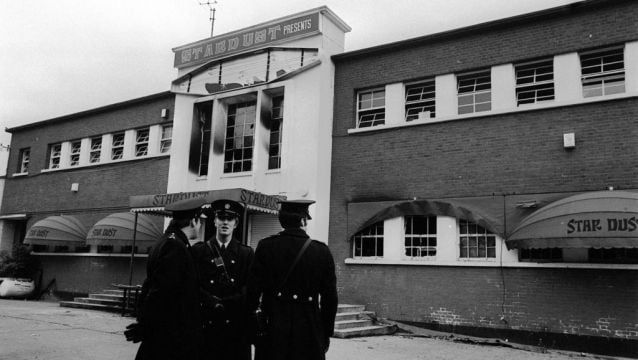The fact that the architects who designed the Stardust nightclub had “little or no knowledge of fire safety” combined with the lack of a sounding fire alarm and exits being obstructed or locked “contributed to the loss of life” on the night of the fire, an expert witness has told an inquest jury.
The inquest also heard on Thursday that all the evidence in relation to the facts of the fire, upon which the jury will be making their deliberations in recording a verdict, has concluded.
A final witness will be called next week.
Martin Davidson, who has 29 years’ experience as a fire engineer, gave his assessment of the overall fire strategy at the nightclub, where 48 people died when fire swept through the building in the early hours of February 14th 1981.
Fire safety
Giving evidence today at the Dublin District Coroner’s Court, Mr Davidson said that the layout of the Stardust from a fire safety perspective was “fundamentally okay”, but the means of escape strategy was “fatally undermined” by a number of factors.
He said that there was a fire alarm on the premises, but it only sent a signal to the management office and did not sound to the patrons. He said this was done at the insistence of Dublin Corporation in order to avoid panic but added that this would have delayed evacuation.
Mr Davidson said that at the Stardust, most of the patrons did not know there was a serious situation until the screens went up at the partitioned-off area where the fire was first observed.
He said that fire regulations make the assumption that there is a good standard of fire safety management in a building, but there was no training for the staff, who were not aware of what to do in the event of a fire.
He said the regulations also make an assumption that surface linings on the walls will be limited, so the fact that there were carpet tiles on the walls “rendered the means of escape redundant”.
The jury was shown a video recreation in which a replica of the west alcove was seen filling with smoke before the smoke spread into the main dance hall.
Mr Davidson said that the critical factors were the seating at the back and the carpet tiles on the walls, and heat was the most crucial factor radiating down from the smoke layer.
“The big thing I take from the video is that the smoke is discharging into an airship hangar, whereas in the Stardust it was discharging into a low ceiling environment,” he said.
He explained that with a high ceiling, the smoke rising draws in air and becomes cool, so there is not much downward radiation, but with a low ceiling the rate of fire growth is much more rapid. The jury had previously heard that the ceiling in the west alcove was below the standard height.
Evacuation simulation
Mr Davidson said an evacuation simulation was carried out, which was not intended to be a recreation of the events in the Stardust as there were too many unknowns to do that, but the recreation did compare scenarios where all exits were available against scenarios where some exits were not available.
He said that in the recreation, it took between 146 seconds and 225 seconds for evacuation when every exit was available, but there was a delay of between 34 seconds and 92 seconds when all exits were unavailable.
“Any delay range within those parameters of 34 seconds and 92 seconds; we believe that the obstruction of those exits would have contributed to the loss of life on the night of the fire,” he said.
He said that as no alarm sounded, the majority of people did not realise the seriousness of the situation until the blinds went up, and then it was too late.
Mr Davidson said a series of tests had shown that investment in staff training has major benefits which should not be underestimated. He said that it has been shown that staff can manage an emergency and assume ownership of the evacuation process.
He said that the Stardust staff had no fire safety training, and it did not appear that anybody tried to evacuate the building. He added that this was not a criticism of the staff, as they had received no training.
Factors
Mr Davidson said that a number of factors contributed to the loss of life, including: the architects commissioned to design the Stardust were not adequately qualified, “with little or no knowledge of fire safety”; multiple breaches of the by-laws; the fact that the means of escape were rendered redundant by the rapid fire growth, which was primarily caused by the carpet tiles and the interaction of those carpet tiles with the polyurethane seats; the lack of a fire alarm and staff training in the event of a fire; and delays due to the exits being obstructed or locked.
“All of these factors combined, in my opinion, contributed to the loss of life on the night, and the time that people needed to get out was much longer than the time they had,” he said.
He said that inspections carried out by Dublin Corporation on the premises during operation revealed that on nine occasions, fire safety management issues were observed relating to the obstructing or locking of exit doors and emergency lighting, and the management were made aware of these.
Mr Davidson said there have been many improvements in building regulations since then, and the chance of a similar fire occurring has been greatly reduced.
Des Fahy KC, representing a number of the families of the deceased, put it to the witness that in the recreation of the evacuation, Mr Davidson had made “conservative assumptions” that were in favour of the Stardust management, such as assuming that certain exit doors were open, but evidence given by witnesses suggested that the doors were not open.
Mr Davidson agreed that it was “entirely possible” that if the added time delay was a further two minutes, it could have been up to three and a half minutes for people to evacuate, and he agreed that this could have been “entirely catastrophic”.
Patricia Dillon SC, representing Dublin City Council, asked Mr Davidson about the breaches of by-laws he had identified concerning steel plates welded on the toilet windows, the use of non-fixed seating, the carpet tiles on the walls, and the metal shutters on exit two.
She said all of these required an application in writing to Dublin Corporation, and she asked if any application had been made by manager Eamon Butterly for a change to the planning in relation to these four items.
Mr Davidson confirmed that no application was made, confirming that local authorities rely upon applications being made in writing.
At the conclusion of Mr Davidson’s evidence, coroner Dr Myra Cullinane said that this now concluded all the evidence in relation to the facts of the fire, and it is on that evidence that the jury will be making their deliberations in recording a verdict.
She said that the final witness in the inquest will be the chief fire officer, who will give evidence about how a major accident of this type would be dealt with today.
The inquest continues next Wednesday in the Pillar Room of the Rotunda Hospital.







